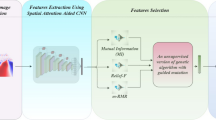Abstract
Detecting arrhythmia from ECG data is now feasible on mobile devices, but in this environment it is necessary to trade computational efficiency against accuracy. We propose an adaptive strategy for feature extraction that only considers normalized beat morphology features when running in a resource-constrained environment; but in a high-performance environment it takes account of a wider range of ECG features. This process is augmented by a cascaded random forest classifier. Experiments on data from the MIT-BIH Arrhythmia Database showed classification accuracies from 96.59% to 98.51%, which are comparable to state-of-the art methods.






Similar content being viewed by others
References
Minami, K., Nakajima, H., and Toyoshima, T., Real-time discrimination of ventricular tachyarrhythmia with Fourier-transform neural network. IEEE Trans. Biomed. Eng. 46(2):179–185, 1999.
Evans, S.J., Hastings, H., and Bodenheimer, M.M., Differentiation of beats of ventricular and sinus origin using a self-training neural network. Pacing Clin. Electrophysiol. 17(4):611–626, 1994.
Clayton, R.H., Murray, A., and Campbell, R.W., Recognition of ventricular fibrillation using neural networks. Med. Biol. Soc. Comput. 32(2):217–220, 1994.
Barro, S., Ruiz, R., Cabello, D., and Mira, J., Algorithmic sequential decision-making in the frequency domain for life threatening ventricular arrhythmias and imitative artefacts: A diagnostic system. J. Biomed. Eng. 11(4):320–328, 1989.
Kastor, J.A., Arrhythmias, 2nd ed. Saunders, London, U.K., 1994.
Ye, C., Kumar, B.V., and Coimbra, M.T., Heartbeat classification using morphological and dynamic features of ECG signals. IEEE Trans. Biomed. Eng. 59(10):2930–2941, 2012.
de Lannoy, G., Francois, D., Delbeke, J., and Verleysen, M., Weighted conditional random fields for supervised interpatient heartbeat classification. IEEE Trans. Biomed. Eng. 59(1):241–247, 2012.
Silva, G., Moody, B., and Celi, L., Improving the quality of ECGs collected using mobile phones: The PhysioNet/Computing in Cardiology Challenge 2011. Proc. Computing in Cardiology, Hangzhou, China. 273–276, 2011.
Oresko, J.J., Jin, Z., Cheng, J., Huang, S., Sun, Y., Duschl, H., and Cheng, A.C., A wearable smartphone-based platform for real-time cardiovascular disease detection via electrocardiogram processing. IEEE Trans. Inform. Tech. in Biomedicine. 14(3):734–740, 2010.
Yen, T.-H., Chang, C.-Y., and Yu, S.-N., A portable real-time ECG recognition system based on smartphone. Proc. IEEE Conf. Eng. Med. Biol. Soc., Osaka, Japan. 7262–7265, 2013.
Leutheuser, H., Gradl, S., Kugler, P., Anneken, L., Arnold, M., Achenbach, S., and Eskofier, B.M., Comparison of real-time classification system for arrhythmia detection on Android-based mobile device. Proc. IEEE Int. Conf. Eng. Med. Biol. Soc., Chicago, Illinois, USA. 2690–2693, 2014.
Park, J., Lee, K., and Kang, K., Pit-a-pat: A smart electrocardiogram system for detecting arrhythmia. Telemed. J. E. Health. 21(10):814–821, 2015.
Pan, J. and Tompkins, W. J., A real-time QRS detection algorithm. IEEE Trans. Biomed. Eng. BME-32(3):230–236, 1985.
Moody, G.B., and Mark, R.G., The impact of the MIT-BIH arrhythmia database. IEEE Eng. Med. Biol. Mag. 20(3):45–50, 2001.
Bhagwat, P., Bluetooth: Technology for short-range wireless apps. IEEE Internet Comput. 5(3):96–103, 2001.
Park, J., Kang, M., Kim, Y., and Kang, K., Heartbeat classification for detecting arrhythmia using normalized beat morphology features. Proc. IEEE Int. Conf. Bioinformatics. Biomed., Washington D.C., USA:1743–1744, 2015.
Park, J., Lee, S., and Kang, K., Arrhythmia detection using amplitude difference features based on random forest. Proc. IEEE Int. Conf. Eng. Med. Biol. Soc. Milan, Italy. 5191–5194, 2015.
Laguna, P., Jane, R., and Caminal, P., Automatic detection of wave boundaries in multilead ECG signals: Validation with the CSE database. Comput. Biomed. Res. 27(1):45–60, 1994.
Afonso, V.X., Tompkins, W.J., Nguyen, T.Q., and Luo, S., ECG beat detection using filter banks. IEEE Trans. Biomed. Eng. 46(2):192–202, 1999.
Kadambe, S., Murray, R., and Boudreaux-Bartels, G.F., Wavelet transform-based QRS complex detection. IEEE Trans. Biomed. Eng. 46(7):838–848, 1999.
Benali, R., Bereksi Reguig, F., and Hadj Slimane, Z., Automatic classification of heartbeats using wavelet neural network. J. Med. Syst. 36(2):883–892, 2012.
Huang, H.F., Hu, G.S., and Zhu, L., Sparse representation-based heartbeat classification using independent component analysis. J. Med. Syst. 36(3):1235–1247, 2012.
Salman, O.H., Rasid, M.F., Saripan, M.I., and Subramaniam, S.K., Multi-sources data fusion framework for remote triage prioritization in telehealth. J. Med. Syst. 38(9):103–126, 2014.
de Chazal, P., O’Dwyer, M., and Reilly, R.B., Automatic classification of heartbeats using ECG morphology and heartbeat interval features. IEEE Trans. Biomed. Eng. 51(7):1196–1206, 2004.
Llamedo, M., and Martinez, J.P., Heartbeat classification using features selection driven by database generalization criteria. IEEE Trans. Biomed. Eng. 58(3):616–625, 2011.
Gama, J., and Brazdil, P., Cascade generalization. Mach. Learn. 41(3):315–343, 2000.
Breiman, L., Random forests. Mach. Learn. 45(1):5–32, 2001.
Kohavi, R., A study of cross-validation and bootstrap for accuracy estimation and model selection. Proc. International Joint Conference on Artificial Intelligence, Quebec, Canada. 1137–1143, 1995.
Acknowledgments
This work was supported by the Ministry of Science, ICT and Future Planning (MSIP), Korea, under the Information Technology Research Center (ITRC) support program (IITP-2016-H8501-16-1018) supervised by the Institute for Information & communications Technology Promotion (IITP), and by an IITP grant funded by the Korea government (MSIP; No. B0101-15-0557, Resilient Cyber-Physical Systems Research).
Author information
Authors and Affiliations
Corresponding author
Additional information
A preliminary version of this work appeared in the proceedings of IEEE BIBM2015
This article is part of the Topical Collection on Mobile & Wireless Health
Rights and permissions
About this article
Cite this article
Park, J., Kang, M., Gao, J. et al. Cascade Classification with Adaptive Feature Extraction for Arrhythmia Detection. J Med Syst 41, 11 (2017). https://doi.org/10.1007/s10916-016-0660-9
Received:
Accepted:
Published:
DOI: https://doi.org/10.1007/s10916-016-0660-9




